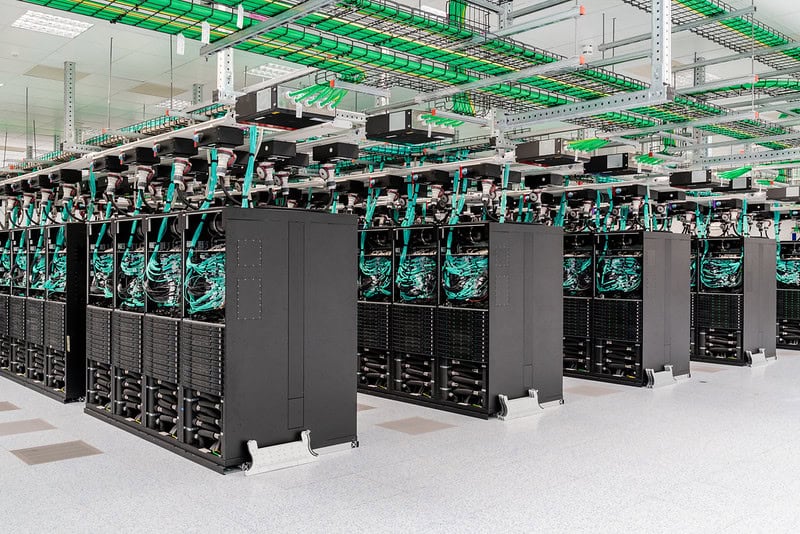As the European Centre for Medium-Range Weather Forecasts celebrates its 50th anniversary, research director Andy Brown discusses the growing impact of AI and machine-learning technologies in weather and climate modelling

What is the main role of the European Centre for Medium-Range Weather Forecasts (ECMWF)?
Making weather forecasts more accurate is at the heart of what we do at the ECMWF, working in close collaboration with our member states and their national meteorological services (see box below). That means enhanced forecasting for the weeks and months ahead as well as seasonal and annual predictions. We also have a remit to monitor the atmosphere and the environment – globally and regionally – within the context of a changing climate.
How does the ECMWF produce its weather forecasts?
Our task is to get the best representation, in a 3D sense, of the current state of the atmosphere versus key metrics like wind, temperature, humidity and cloud cover. We do this via a process of reanalysis and data assimilation: combining the previous short-range weather forecast, and its component data, with the latest atmospheric observations – from satellites, ground stations, radars, weather balloons and aircraft. Unsurprisingly, using all this observational data is a huge challenge, with the exploitation of satellite measurements a significant driver of improved forecasting over the past decade.
In what ways do satellite measurements help?
Consider the EarthCARE satellite that was launched in May 2024 by the European Space Agency (ESA) and is helping ECMWF to improve its modelling of clouds, aerosols and precipitation. EarthCARE has a unique combination of scientific instruments – a cloud-profiling radar, an atmospheric lidar, a multispectral imager and a broadband radiometer – to infer the properties of clouds and how they interact with solar radiation as well as thermal-infrared radiation emitted by different layers of the atmosphere.
How are you combining such data with modelling?
The ECMWF team is learning how to interpret and exploit the EarthCARE data to directly initiate our models. Put simply, mathematical models that better represent clouds and, in turn, yield more accurate forecasts. Indirectly, EarthCARE is also revealing a clearer picture of the fundamental physics governing cloud formation, distribution and behaviour. This is just one example of numerous developments taking advantage of new satellite data. We are looking forward, in particular, to fully exploiting next-generation satellite programmes from the European Organisation for the Exploitation of Meteorological Satellites (EUMETSAT) – including the EPS-SG polar-orbiting system and the Meteosat Third Generation geostationary satellite for continuous monitoring over Europe, Africa and the Indian Ocean.

What other factors help improve forecast accuracy?
We talk of “a day, a decade” improvement in weather forecasting, such that a five-day forecast now is as good as a three-day forecast 20 years ago. A richer and broader mix of observational data underpins that improvement, with diverse data streams feeding into bigger supercomputers that can run higher-resolution models and better algorithms. Equally important is ECMWF’s team of multidisciplinary scientists, whose understanding of the atmosphere and climate helps to optimize our models and data assimilation methods. A case study in this regard is Destination Earth, an ambitious European Union initiative to create a series of “digital twins” – interactive computer simulations – of our planet by 2030. Working with ESA and EUMETSTAT, the ECMWF is building the software and data environment for Destination Earth as well as developing the first two digital twins.
What are these two twins?
Our Digital Twin on Weather-Induced and Geophysical Extremes will assess and predict environmental extremes to support risk assessment and management. Meanwhile, in collaboration with others, the Digital Twin on Climate Change Adaptation complements and extends existing capabilities for the analysis and testing of “what if” scenarios – supporting sustainable development and climate adaptation and mitigation policy-making over multidecadal timescales.
Progress in machine learning and AI has been dramatic over the past couple of years
What kind of resolution will these models have?
Both digital twins integrate sea, atmosphere, land, hydrology and sea ice and their deep connections with a resolution currently impossible to reach. Right now, for example, the ECMWF’s operational forecasts cover the whole globe in a 9 km grid – effectively a localized forecast every 9 km. With Destination Earth, we’re experimenting with 4 km, 2 km, and even 1 km grids.
In February, the ECMWF unveiled a 10-year strategy to accelerate the use of machine learning and AI. How will this be implemented?
The new strategy prioritizes growing exploitation of data-driven methods anchored on established physics-based modelling – rapidly scaling up our previous deployment of machine learning and AI. There are also a variety of hybrid approaches combining data-driven and physics-based modelling.
What will this help you achieve?
On the one hand, data assimilation and observations will help us to directly improve as well as initialize our physics-based forecasting models – for example, by optimizing uncertain parameters or learning correction terms. We are also investigating the potential of applying machine-learning techniques directly on observations – in effect, to make another step beyond the current state-of-the-art and produce forecasts without the need for reanalysis or data assimilation.
How is machine learning deployed at the moment?
Progress in machine learning and AI has been dramatic over the past couple of years – so much so that we launched our Artificial Intelligence Forecasting System (AIFS) back in February. Trained on many years of reanalysis and using traditional data assimilation, AIFS is already an important addition to our suite of forecasts, though still working off the coat-tails of our physics-based predictive models. Another notable innovation is our Probability of Fire machine-learning model, which incorporates multiple data sources beyond weather prediction to identify regional and localized hot-spots at risk of ignition. Those additional parameters – among them human presence, lightning activity as well as vegetation abundance and its dryness – help to pinpoint areas of targeted fire risk, improving the model’s predictive skill by up to 30%.
What do you like most about working at the ECMWF?
Every day, the ECMWF addresses cutting-edge scientific problems – as challenging as anything you’ll encounter in an academic setting – by applying its expertise in atmospheric physics, mathematical modelling, environmental science, big data and other disciplines. What’s especially motivating, however, is that the ECMWF is a mission-driven endeavour with a straight line from our research outcomes to wider societal and economic benefits.
ECMWF at 50: new frontiers in weather and climate prediction
The European Centre for Medium-Range Weather Forecasts (ECMWF) is an independent intergovernmental organization supported by 35 states – 23 member states and 12 co-operating states. Established in 1975, the centre employs around 500 staff from more than 30 countries at its headquarters in Reading, UK, and sites in Bologna, Italy, and Bonn, Germany. As a research institute and 24/7 operational service, the ECMWF produces global numerical weather predictions four times per day and other data for its member/cooperating states and the broader meteorological community.
The ECMWF processes data from around 90 satellite instruments as part of its daily activities (yielding 60 million quality-controlled observations each day for use in its Integrated Forecasting System). The centre is a key player in Copernicus – the Earth observation component of the EU’s space programme – by contributing information on climate change for the Copernicus Climate Change Service; atmospheric composition to the Copernicus Atmosphere Monitoring Service; as well as flooding and fire danger for the Copernicus Emergency Management Service. This year, the ECMWF is celebrating its 50th anniversary and has a series of celebratory events scheduled in Bologna (15–19 September) and Reading (1–5 December).



